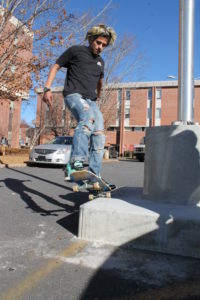Co-written/ produced with Julia Lewis

David Lozano-Alvarez photo by Julia Lewis
Cast your mind back to the year 2004. If you were between the ages of 9 and 20 at that time, then you will almost certainly remember the stranglehold that skateboarding had on many of your friends’ lives.
That year could be considered the peak of skateboarding in the mainstream, and it was everywhere. Skate shoes were the style, even if the person wearing them had never set foot on a skateboard, and Bam Margera, primarily a professional skateboarder, had even begun to make a name for himself in television and film, firmly cementing the idea of skating as “popular culture” in the minds of the masses.
But now, 12 years on from the height of its popularity, skateboarding is a much more niche activity (disregarding the fact that it was just accepted into the Olympics). If you were a student at Western Carolina University and you didn’t already know, then you might think that skateboarding isn’t even a thing people do anymore.
However, there is a dedicated group of skaters who continue to pursue the activity as part of their lives. This reporter wanted to find out why they choose to indulge in such an unfashionable activity when the possible rewards are few and almost certainly not worth the pain that goes into the activity.
Three skateboarders offered to be involved in this inquisition: David Lozano-Alvarez, Riley Seyffert and Matthew Impagliatelli. In order to more thoroughly understand why they continue to participate in skateboarding, it seemed appropriate to find out how they started. Unsurprisingly, the origin stories of their forays into skateboarding were all very similar: tales of neighbors with skateboards and how cool skateboarding seemed as a young outsider.
“I had a friend and he would always be skating at his house and I would go there a lot. His dad had built him this little ramp and I had been playing sports all my life, so I was like ‘okay, I can [do] that.’ I tried rolling off this little ramp and I busted my lip. For the first time I realized I couldn’t just do this thing. It wasn’t like other sports I played that I could learn a lot faster. Skating is so different,” David Lozano-Alvarez said.
So why continue to do something if you get hurt the first time you try?
“Sometimes just face-planting and eating the concrete is one of my favorite things,” Matthew said. “Pain is an incentive to skateboarding, not a deterrent.”
But what about the long-term goals of skateboarding? It is completely possible to live a very comfortable life as a professional skateboarder but it takes work and dedication to reach the skill level expected of pros. So I had to ask my sources why they continued to skate once they realized they wouldn’t be able to reach that level. David and Matthew both explained that it was never about being a professional for them. It was about the thrill of doing it. Riley, however, had a different take.
“You see, the problem with that question is that I have not realized I’m not going to reach the pro level. Right now is a small detour in my life to get an education. As soon as I have that then there will be nothing stopping me from actually pursuing that dream or using my education in collaboration with my skateboard skills to achieve my dream,” he explained.
For those of you who aren’t familiar with skateboarding, the following video, which is from the perspective of an outsider to skateboarding, may help shed a little more light on skateboarding and may even give you a reason to try it.


